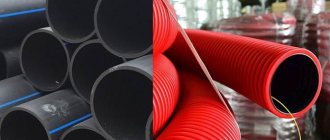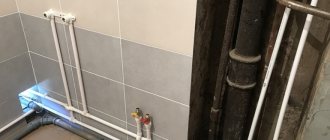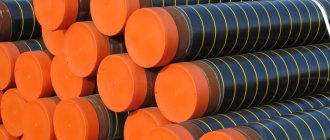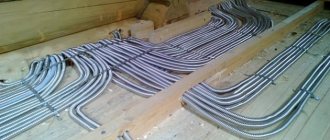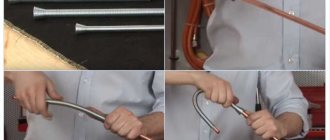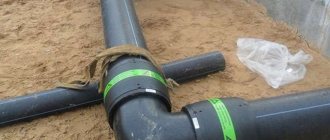Horizontal directional drilling (HDD) is a method of laying pipes and cables without digging trenches, usually performed under roads and railways. To implement this method, special equipment is used, which includes directional drilling rigs. With the help of such installations, work is carried out 90% underground.
The horizontal drilling method is a modern way of laying pipelines for various purposes
The preparatory stage is the approval of HDD punctures on the site.
1.1. The customer, before the work related to laying the HDD pipeline begins, transfers, according to documents, to the direct contractors the alignments of the underground passages, which are fixed with geodetic signs with the required number of benchmarks within the boundaries of the territory of the work being carried out. The axis of the route, during its drawing in nature, is strengthened with special signs tied to permanent objects.
Three days before the start of work on HDD technology, the customer invites representatives of the organizations that operate the facility and coordinates with all owners of communications and structures the trenchless laying areas located in the work area.
1.2. The contractor carries out a control inspection of the work site for the presence of risk, or rather, its absence, for example, signs for underground cables, manhole covers, distribution cabinets, water or gas meters, external communications near objects. Carrying out security actions, if they are provided for by the project, as well as clarifying the design profile for drilling a well.
1.3. Purchase of pipes intended for HDD, the diameter indicated according to the diagram. To lay a pipeline using the HDD method, polyethylene pipes with a blue stripe for water supply systems or pressure sewerage are purchased, or without technical stripes, with a thickened wall for laying cables using the HDD method underground, since pressure from the outside increases. The insulating properties will be lost if the pipe ruptures.
You can purchase a pipe for cable laying using the HDD method on our website by submitting an application. We will call you back, or you can call
Advantages of trenchless installation
The use of a trenchless method for constructing pipelines has the following advantages:
- no need to block traffic on sidewalks, railways and roads;
- you can lay wells in wet soil without additional costs for drainage;
- the surface infrastructure is preserved, the integrity of the grass cover and ornamental plantings is not compromised;
- reduction of costs for preparatory work, elimination of consequences occurs faster;
- speed of passage of the route due to the use of productive equipment;
- causing minimal damage to the environment, since drilling is carried out in a limited area;
- high precision of laying when work is carried out within the city, where there are natural and engineering obstacles underground;
- the ability to use one of the methods most suitable for performing a particular task.
The differences between the open installation method are the high construction costs and the difficulties in obtaining permits.
Equipping production sites for punctures using the HDD method under the road.
2.1. The territory where the pipeline will be laid using the HDD method is usually located on both sides of the obstacle being crossed and is divided into two separate construction and installation sites.
Conventionally, they are called:
- site No.1 of the working (starting) pit and drilling rig
- site No.2 of the receiving pit
2.2. Both areas must be cleared and leveled.
2.3. The starting pit is most often equipped on the side of the well where it is more convenient to approach and there is enough space to organize a construction site.
2.4. To organize the transportation of equipment and cargo, temporary access tracks are installed to the installation sites for puncturing using the HDD method. At the construction stage, the construction strip is planned. At the same time, various kinds of depressions are filled in, the relief is leveled, and the bumps are cut off. Excavation work is carried out by the Contractor.
2.5. The installation site is a receiving pit, the dimensions of which will be 3000.0 x 3000.0 x 5000.0 mm.
What are drilling rigs for horizontal directional drilling?
What does the complex consist of? It includes the drilling rig itself and a unit for preparing the solution for the drilling process.
All equipment can easily fit into a small trailer, which makes such an installation mobile and autonomous. Therefore, such a complex can be transported to any distance.
The advantage of the technology is quick installation (2-4 hours). Using the technique, the time required to complete the work is reduced by approximately 1.5 times.
In one shift, the team will be able to lay approximately 100 meters of pipeline if they use the horizontal directional drilling method, the technology of which is available to all modern oil producing companies.
It is worth noting that such installations are capable of working from the surface of the earth, unlike traditional devices for which pits or small depressions are dug. This does not disturb the fertile soil layer and does not have a detrimental effect on the ecosystem.
For HDD, special complexes are used that are installed on the surface layer of soil. The installation depth should not exceed 15 m. Drilling is carried out along a predetermined trajectory. In this case, the hole after drilling has a small diameter.
The advantage of the technique is the high accuracy of the geolocation system. The maximum permissible deviation of the device is 0.1%. Those. out of 100 meters, the deviation can be no more than 10 cm. This allows you to determine the coordinates of the drill head and lay out the route according to the project without any difficulty.
Only after the work has been done, the well is expanded to a larger diameter, which will allow installation of the pipeline system.
The oil and gas industry currently plays a major role in the economic advancement of the state, being the most competitive sphere of production in the world. Therefore, it is worth paying as much attention as possible to improving technologies and developing existing ones, such as horizontal directional drilling.
Modern production of equipment for the oil and gas industry is usually carried out with the participation of software. Operating this type of technology requires a high level of training.
Thanks to qualified personnel, as well as the technologies and methods used, today oil and gas equipment is in no way inferior to Western analogues, and in terms of price characteristics it occupies more advantageous places.
Equipping the construction site before the start of HDD puncture
3.1. Before starting the main construction work, the following preparations must be carried out:
- underground communications discovered in the work area must be opened with pits. This is done to determine the depth of their laying. They are then marked with warning signs;
- work areas are fenced off with a standard fence, with the simultaneous installation of the necessary road signs;
- a strip along the route is cleared, accompanied by cutting down and replanting green spaces, if any.
- temporary access and internal roads are being built;
- general-site warehouses are created;
- The construction site is provided with water supply and fire-fighting equipment, alarm and communication equipment.
3.2. Construction mechanisms are mounted on a leveled, stable base, which should not have a slope greater than that allowed by the technical data sheet. Near the protruding parts of construction mechanisms, a free passage of at least 1 m in width must be left.
3.3. The pit under construction must be fenced with railings no less than 1.1 m high. In the dark, the fence must be illuminated.
Starting pit for puncture using HDD method
4.1. The depth of the starting pit is determined taking into account the distance from the axis of the pipeline to the bottom of the shaft. It all depends on the design of the butt joints and the drilling rig.
4.2. In free areas, it is better to design the starting pit with a rectangular outline. Then, if necessary, it will be possible to increase the length of the installation sections of the pipeline.
4.3. The foundation of the pit must be planned according to the slope of the future well. It is necessary that the base is strong enough to avoid subsidence of the equipment. The base under the drilling rig is made of crushed stone of fraction 25-70, the thickness of which is from 15 to 20 cm. Then the base is compacted and road slabs are laid. If the pit is short, then 2 pieces, and if it is long, then 3 or filled with concrete.
4.4. When drilling, there is almost always a possibility of flooding of the pit. Therefore, during the construction of the starting pit, a pit is made to install a water pump to pump out water. This will keep the bottom of the pit dry and able to bear the load at all times. The pit is usually located in front of the pit on the right side. This location is determined by the slope of the base of the pit, which will allow water to be drained away from the drilled rock that accumulates to the left of the drilling rig.
Pilot well
5.1. Immediately after completion of the preparatory work, you can begin laying pipes using directional horizontal drilling. For this purpose, the drilling rig is placed in the desired location. Then it is necessary to check (drill a pilot well). The cross-section of this well should be approximately 100 mm.
5.2. If there is a need to make a pilot hole for HDD under a road or railway tracks, then the progress of the drilling element must be regulated using a geolocation system. Without using this system or if it is inoperative, trenchless work is prohibited.
5.3. The initial position of the drill head is usually 10-20 degrees to the horizon. The angle should constantly decrease depending on the depth of immersion. After reaching the required depth for laying the pipeline using the HDD method, drilling is performed in a horizontal plane. When drilling, you can adjust the direction of movement of the drill bit. Correction is made in case of deviation from the specified direction.
5.4. Piercing method - checking the position of the drill using a geolocation system every 3 m. Having passed a certain point, the drill head begins to move upward, which makes it possible to reach the exit point. Both the exit from the ground and the entrance must be pre-calculated and made strictly at a certain angle.
Necessary equipment
All equipment used for drilling using the HDD method is divided into several main types:
- machine for horizontal directional HDD drilling;
- location system for drilling;
- secondary components (staples, clamps, etc.).
A locating system for drilling horizontal wells is necessary to organize control over the drill. This is very important, since the drill is located in the soil during operation, that is, outside the visible zone. This system protects the drill from colliding with various obstacles that could damage the drilling equipment.
The geolocation system for monitoring the work process is equipped with a mini-probe, which is necessary to track geolocation indicators during drilling. The mini-probe is installed on the drill head and on the apparatus. The data transmitted by the probe is sent to the operator, who makes corrections to the work process.
It is worth noting that equipment for HDD is quite expensive and belongs to professional equipment. A horizontal drilling unit (HDU) can have different configurations, however, all such machines consist of the following structural elements:
- body;
- engine;
- chassis.
Equipment for HDD is professional and has a high cost
The functional part of the UGNB consists of three main components:
- drilling element;
- a hose that supplies water to the drilling element (this is necessary for cooling the drill);
- control Panel.
All UGNB are classified according to one main indicator - the limiting broaching force. Other characteristics of these machines include:
- indicators of the channel cross-section that such a machine can perform;
- maximum channel length;
- bentonite consumption rate (l/min);
- the use of the horizontal drilling method also takes into account the maximum possible bending radius of the drill rods. This indicator is considered very important, as it affects the mobility of the drilling rig and its ability to bypass various obstacles.
Secondary equipment includes the following devices:
- fixing elements;
- adapters;
- expanders;
- pump equipment;
- generators operating on electricity;
- lighting devices.
The horizontal drilling rig must be selected correctly, in accordance with all the factors listed above.
Well expansion
6.1. At this stage, the diameter of the pilot well is increased using an expander. For this purpose, the drill head is disassembled and a rimmer (special device) is installed instead. A rimmer is a structural element used during pipe laying using the HDD method, which performs the function of expanding the pilot channel. It must be said that the rimmer serves to expand the reverse action. The device extends from the channel exit to its input.
6.2. The creation of a borehole is carried out by pushing out and compacting the soil due to the rotation of the expander and the supply of bentonite solution through it. Sometimes you may need to perform the expansion several times. In such cases, the diameter of the expander gradually increases. The final diameter of the well should be from 135 to 150% of the diameter of the future pipeline.
6.3. It should also be noted that all work must be performed using coolant. The fact is that the equipment used for geolocation is very sensitive to temperature increases. Road piercing is a serious undertaking. Therefore, all stages of work must be thought out.
6.4. There is another important factor that must be taken into account; the soil tends to crumble. Also, a puncture under the road surface using the HDD method should take into account the fact that before pulling metal or plastic pipes into the well, they need to be connected. Everything must be done carefully and reliably. Otherwise problems may arise. Then, with the equipment turned off, the annular expander is connected to the rods. After this, the necessary communications are connected through a rotating swivel. To carry out this operation, you will need a special adapter element or other suitable device.
Installation difficulties
When installers lay underground communications, in the process of preparatory, main and restoration work they have to deal with problems of a different nature.
The most common difficulties are:
- Planning. If workers have to drill a well within a populated area or in the suburbs, they need to gain access to layout diagrams of underground communication lines, power cables, pipelines, sewers and other engineering facilities. After this, it is necessary to develop a competent project that involves bypassing these obstacles.
- Work in swampy areas and unstable soil. Additional costs and time are expected to arrange access roads and a reliable foundation for placing special equipment. A large amount of manual labor involved in excavating soil from pressed-in pipes.
- Passage of buried objects (reservoirs and real estate). The need to use expensive navigation equipment and constant correction of the direction of movement of the drill string.
Despite the difficulties and difficulties, the use of trenchless technology is in all aspects more profitable than methods of surface laying and placing pipes in ditches.
Laying the pipeline
7.1. A string of the pipeline being laid is attached to the expander by gripping the pipe through a swivel.
7.2. Next, the pipeline is pulled, which goes into the previously created well. The puncture process is under the control of the HDD operator. Upon completion of the broaching process, excess bentonite is removed in both pits, the initial and final ones.
Process economics
Every adequate specialist strives to ensure that any production process, any technological operation is carried out with minimal costs.
Many years of practice have proven that the price of HDD puncture is lower than all other methods of performing this type of work. This is especially noticeable when drilling is carried out in densely populated areas. And HDD puncture under the road is just an illustrative example of the advantages of this technology over all others that are used in this industry.
Dismantling and removal of equipment
8.1. When the case is in the receiving pit, the installation is disassembled. The expander and pilot rods are removed from the receiving pit, and the drilling rig is removed from the starting pit.
8.2. Between workers who are in the starting and receiving pits, reliable communication in both directions must be ensured.
8.3. After completion of construction and installation work, all equipment is disassembled and removed from construction sites. Then the terrain is graded and the pits are filled.
